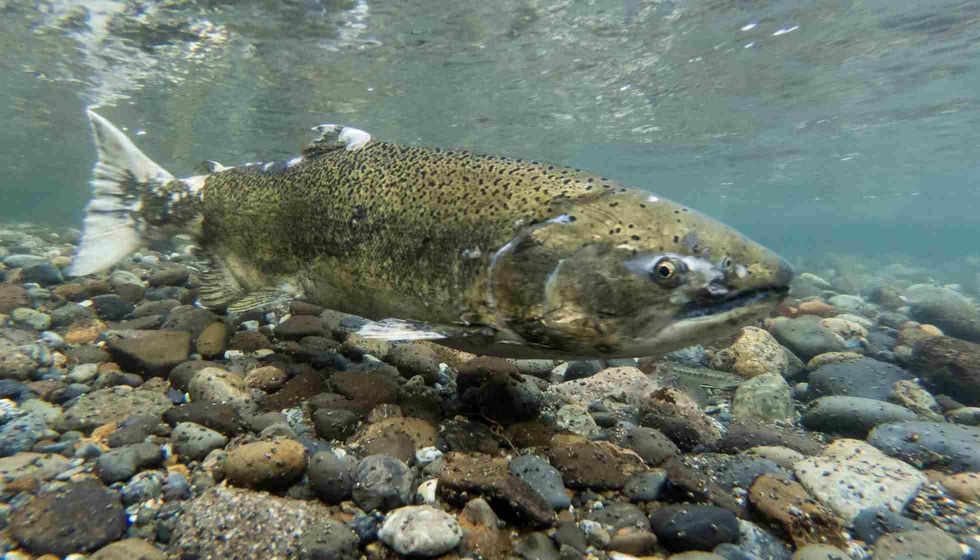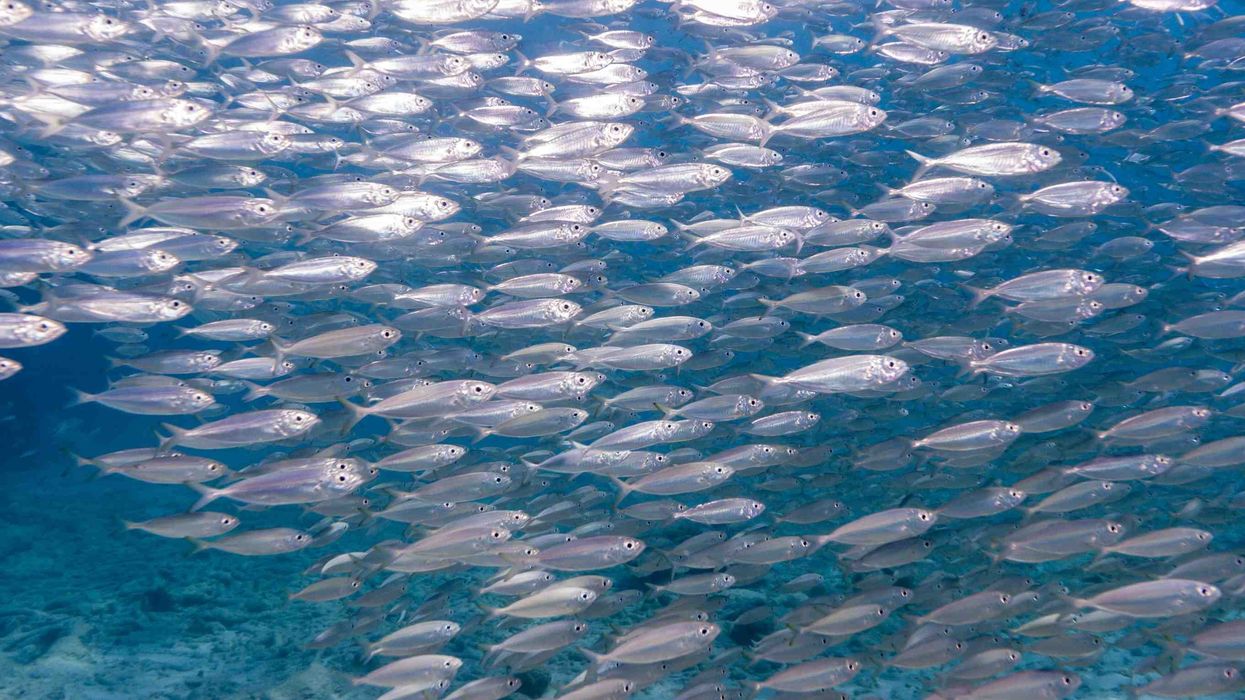King salmon or Chinook salmon (Oncorhynchus tshawytscha) is the largest Pacific salmon species which is why they have the word 'king' in their name, as well as the largest in the Oncorhynchus genus. Their name is derived from the Chinookan people.
Chinooks are anadromous (fish born in freshwater who spend most of their lives in saltwater before coming back to freshwater to spawn) fish indigenous to the river systems of Northwestern America, which ranges from California to Alaska. They can also be found in Asian rivers in Northern Japan and the Palyavaan River in the northeast Siberian Arctic regions.
King salmon spend their first couple of years living in freshwater before migrating to the ocean and after between two and four years they come back to their spawn to mate and give birth to the next generation.
If you liked these true facts about Spanish mackerel, then you'll surely like these facts about salmon and albacore.
King Salmon Interesting Facts
What type of animal is a King Salmon?
King salmon, also famous as the Chinook salmon, is a large species from the Salmonidae family. King salmon are native to the North American pacific coast and are one the largest of all Pacific salmon subspecies.
The other salmon in the genus Oncorhynchus are cutthroat trout, pink salmon, dog salmon, rainbow trout, and the Coho salmon.
What class of animal does a King Salmon belong to?
King salmon belongs to the Actinopterygii class of fish.
Actinopterygians are known to be the dominant class in the vertebrates and comprise nearly 99% of over 30,000 fish species. Fish of this class can be found throughout freshwater and marine environments from the deep sea to the highest mountain streams.
How many King Salmon are there in the world?
As king salmon are found in large numbers, an approximation of their population is hard to pinpoint. But it is known that their population is decreasing at an alarming rate because of poaching, logging, habitat loss, and unchecked harvesting.
Where does a King Salmon live?
King salmon, like most of the Salmonidae family, have a life cycle that is anadromous. They lay eggs in freshwater habitats and the eggs hatch in these habitats which include streams and creeks. As they grow old, they move downstream into larger rivers, estuaries, and ponds.
Adults spend years in the ocean before they return to freshwater habitats to spawn.
What is a King Salmon's habitat?
King or Chinook salmon inhabit mostly freshwater lakes, streams, rivers as their spawning and rearing ground.
Juvenile Chinook salmon are found in the ocean where fish bait is easily available, commonly in ranges of 30-60 feet depth.
Mature Chinook salmon run along the shoreline of oceans and rivers as they 'smell' their way back to natural freshwater habitats.
Who do King Salmon live with?
King or Chinook salmon species stay together in a school in order to protect themselves, which in turn confuses predators with their flashy sides, causing the predator to mistake the Chinook school as a large predator itself.
How long does a King Salmon live?
The Chinook salmon species has a short life cycle that can extend depending on the habitat these fish live in. The ocean-dwelling king salmon can survive up to five years in the ocean, reaching almost eight years of age.
The average lifespan of king salmon is anywhere from three to seven years.
How do they reproduce?
King salmon reach sexual maturity when they are between three and seven years of age, they make the long migratory journey back to the site of their birth after living years in the ocean in order to produce young.
At their respective birth spawn male and female king salmon pair up to breed. The time and population of the salmon are a factor in their breeding practices, but mostly breeding or spawning season is in the summer and fall.
A female digs a redd (nesting hole), where she will deposit thousands of eggs and the male will fertilize these eggs. Because they spend so much time swimming back to their birthplace, they spend a lot of energy, and by the time the eggs hatch in a period of 90 to 150 days, both the parents will have died.
What is their conservation status?
King salmon is currently listed as a Non Extinct species by the IUCN Red List.
Their population, however, is declining due to human activities like logging in streams as it reduces the nutrients and shade that is available in the stream, also increasing the amount of dirt or silt in the water, which in turn can damage and choke out developing eggs.
King Salmon Fun Facts
What do King Salmon look like?

King salmon, like most members of the Salmonidae family, change their appearance drastically while spawning. These northern Pacific ocean dwellers have silver-colored scales which are accompanied by hints of blue-green shade. They have a unique coloration that is black on their mouth.
Their scales darken while spawning and acquire a hue that is reddish in color, with which their mouth will elongate and become hooked.
King salmon is the largest in the Oncorhynchus genus.
How cute are they?
King salmon aren't the cutest of fish. Babies might be cute but the adults aren't. They have an aggressive look on their faces that can be scary to look at.
How do they communicate?
These fish require precise communication in the mating and spawning procedure, the male will vibrate and cross the females while the female is digging the redd for laying eggs. The female is seen to prefer the larger males who vibrate more.
How big is a King Salmon?
The king salmon is the biggest species of salmon and usually grows from about 24 in (61 cm) to 58 in (150 cm) long.
How fast can a King Salmon swim?
An accurate swimming speed of king salmon is hard to pinpoint due to the lack of proper research. They swim in short bursts for approximately 30 seconds at a time, and river sections with high velocity in the water only hinder their speed.
However, these fish swim at a variety of speeds depending on the habitat they are in. Their swimming speed in the ocean is much better than their speed in rivers and ponds as they have to cross waterfalls, and rivers to get to their spawn point.
How much does a King Salmon weigh?
King salmon can weigh from anywhere between 10 lb (4.5 kg) to 50 lb (22.7 kg).
What are their male and female names of the species?
No specific name has been assigned to either sex of the fish.
What would you call a baby King Salmon?
A newly hatched king salmon is called an alevin. When they are alevins, they look like threads with eyes and a yolk sac. They remain in the spawning location, more accurately, the redd, until they absorb the yolk sac. Alevins slowly move up through the nest and soon start swimming freely in the water body they are in.
They are called 'fry' when they have grown up enough to come out of their nest.
What do they eat?
Chinook salmon fry feed on plankton and other small insects in freshwater.
In the ocean, these fish have a wide diet that includes various seafood like herring, squid, and other smaller crustaceans. With a proper diet, they grow rapidly in the ocean and are known to become double their weight during a single summer season.
Are they dangerous?
They are not dangerous but will bite when they enter the river, out of anger, even trying to bite when they are caught by humans. The bite however isn't much of a danger.
However, they do carry bacteria caused by the pathogen Yersinia ruckeri, which in turn causes enteric redmouth disease. It is mostly found in fish farms that have poor water quality and will cause sickness when the salmon is caught and consumed by humans.
Would they make a good pet?
No, they will not make a good pet as these fish have a complicated life. They spend most of their life in saltwater environments and come back to their native freshwater streams for the purpose of spawning.
The dietary and environmental conditions for a king salmon to thrive is impossible to replicate, like a river or a sea spawn habitat in aquariums, hence making them almost impossible to keep as pets.
Another reason for not keeping king salmon as a pet is the game laws of the country in which you live. Many countries forbid keeping game fish as pets, due to their normal size limits. Also, you would need a fishing license and a salmon permit to keep king salmon as pets.
Did you know...
'Jacks' are juvenile Chinook salmon maturing in a single winter in the ocean and then shortly after coming back to their spawn. Jacks are generally male.
Immature king salmon that are caught off the shore in salt water is the salmon that tastes the best.
King salmon is the state fish of Alaska.
White king salmon are genetically mutated which is the cause of their white meat instead of the normal pink meat. These rare salmons are said to be delicious.
Unlike normal salmon, king salmon is one of the finest salmon that can be caught in the sea and river bodies, and they are rich in omega-3 oils and a better taste!
If you want to eat one, you can buy a king salmon in any fish market that sells good quality seafood.
Male king salmon outnumber females during spawning.
Females take longer to become sexually mature in comparison to males.
In Kamchatka, Russia, the name for King salmon is 'Tshawytscha'.
Some native Americans still celebrate 'first salmon ceremonies' annually to pay tribute to the historical value of king salmon.
King salmon are expensive because of their high demand and difficulty in catching them, in comparison to other fish.
Catching and eating King Salmon
It requires patience and effort to catch a King salmon! Here are some of the steps that you can follow!
Step 1: Use bait like anchovies to hook these fish when you go out fishing.
Step 2: Keep a focus on flocks of seabirds diving in a particular spot. This means there are fish around that area.
Step 3: Drop the bait in the water and make sure to move it to imitate the movement of the anchovy to bait the salmon.
Step 4: When you know the salmon has taken a bite of the bait, slowly grab the pole and reel it in slow and steadily. In case of a tussle, let the salmon wear itself out.
Step 5: Once the salmon is caught, cut the gills so it bleeds out quickly. And then put it in a cooler. And with that, you're done!
King Salmon is high in fat, and their meat contains omega-3s which is a great source of fat. King salmon is considered to be one of the most delicious fish thanks to its buttery smooth texture.
Ora king salmon is developed for the foodservice industry and is a prized delicacy. Ora king salmon is what Wagyu is to beef.
Differences with other Salmon
Chinook or king salmon is the largest of the Pacific salmon species.
Regarding taste, the king salmon is the one that delivers a deep and rich flavor compared to other salmons.
Here at Kidadl, we have carefully created lots of interesting family-friendly animal facts for everyone to discover! Learn more about some other fish including codfish and rainbow trout.
You can even occupy yourself at home by drawing one of our king salmon coloring pages.










